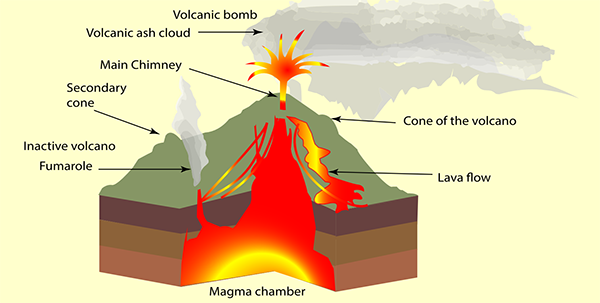Here you will get all details about “Earthquake Definition, Causes And Its Effects”. We have listed all causes of Earthquake in detail here. You will get complete knowledge about Earthquake here. Keep Visiting – Vlcinfo
Earthquake Definition
An earthquake is a sudden shaking of the ground which is caused by the movement of tectonic plates under the Earth’s surface.
It occurs when stress accumulated along geological faults or plate boundaries is released, resulting in the rapid release of energy in the form of seismic waves. These seismic waves propagate through the Earth, causing the ground to shake and sometimes resulting in the displacement of the Earth’s surface.
The intensity and effects of an earthquake generally depend on some factors like its magnitude, depth, local geological conditions and proximity to populated areas .
The study of earthquakes is known as seismology, and scientists use seismographs and other instruments to monitor and measure seismic activity.
Causes of Earthquake
Earthquakes are generally caused by the movement of tectonic plates under the Earth’s surface. The Earth’s crust is divided into several large and small plates. These plates are constantly in motion due to the heat-driven convection currents in the Earth’s mantle. The interaction between these plates at their boundaries leads to the release of energy in the form of earthquakes.
Here are the main causes of earthquakes described below.
Tectonic Plate Movement
Most of earthquakes are caused generally by the movement of tectonic plates. There are three main types of plate boundaries where earthquakes occur.
| Types of plate boundaries | Details |
|---|---|
| Divergent Boundaries | Plates move away from each other, creating tension stress and often resulting in shallow earthquakes along mid-ocean ridges or rift zones. |
| Convergent Boundaries | Plates collide with each other, leading to compressional stress and the formation of deep-focus earthquakes in subduction zones or mountain ranges. |
| Transform Boundaries | Plates slide past each other horizontally, generating shear stress and producing strike-slip earthquakes along faults. |
Volcanic Activity
- Earthquakes can be triggered by volcanic activity, particularly during the movement of magma beneath the Earth’s surface. As magma rises and intrudes into the crust, it can cause the surrounding rocks to fracture and generate earthquakes.
- Additionally, the collapse of volcanic edifices, known as volcanic earthquakes or collapse earthquakes, can occur during explosive volcanic eruptions or the subsidence of lava domes.
Human Activities
Certain human activities, such as mining, reservoir-induced seismicity and hydraulic fracturing (fracking) for oil and gas extraction, can induce earthquakes by altering the stress regime in the Earth’s crust.
| Human Activities | Details |
|---|---|
| Mining | Removing minerals from the Earth’s crust can create large underground cavities, leading to the collapse of overlying rocks and the generation of seismic waves. |
| Reservoir-Induced Seismicity | The filling of large reservoirs behind dams can increase the pore pressure in the surrounding rocks, triggering earthquakes. |
| Hydraulic Fracturing (Fracking) | Injecting fluids into underground rock formations to extract oil and gas can induce slip along pre-existing faults, leading to earthquakes. |
Faulting and Fracturing
- Faults are fractures or zones of weakness in the Earth’s crust along which movement has occurred. When stress builds up along a fault due to tectonic forces, it can eventually overcome the frictional resistance, causing the rocks to rupture and release energy in the form of seismic waves.
- Earthquakes can also occur due to the movement of faults that are not directly associated with plate boundaries, known as intraplate earthquakes. These earthquakes often occur in regions with ancient faults or zones of crustal weakness.
Effects of Earthquake
Here you can find effects of earthquake below.
| Effects of Earthquake | Details | Effects |
|---|---|---|
| Ground Shaking | The most immediate and noticeable effect of an earthquake is the shaking of the ground. The intensity of shaking depends on factors such as the earthquake’s magnitude, depth, distance from the epicenter, and local geological conditions. | Ground shaking can cause buildings, infrastructure, and natural features such as cliffs and slopes to sway, crack, or collapse, leading to structural damage and potential casualties. |
| Tsunamis | Underwater earthquakes, particularly those associated with subduction zones, can generate tsunamis—large, fast-moving waves that propagate across the ocean surface. Tsunamis can travel thousands of kilometers and inundate coastal areas with devastating force. | Tsunamis can cause extensive flooding, erosion, and destruction of coastal infrastructure, as well as loss of life and displacement of populations living near the coast. |
| Surface Rupture | Along faults, particularly at the Earth’s surface, the movement of tectonic plates during an earthquake can cause the ground to rupture or offset. This displacement can result in the formation of surface ruptures, where one side of the fault moves relative to the other. | Surface ruptures can disrupt roads, railways, pipelines, and other linear infrastructure, posing challenges for transportation and utility networks. |
| Secondary Hazards | Earthquakes can trigger secondary hazards such as fires, gas leaks, and dam failures. Shaking can rupture gas lines, ignite fires, and damage water and sewage infrastructure, leading to secondary disasters. | Firefighting efforts may be hampered by damaged infrastructure, limited access, and disrupted water supplies, exacerbating the impact of the earthquake on affected communities. |
| Landslides and Avalanches | Earthquakes can trigger landslides, rockslides, and avalanches on steep slopes, especially in mountainous regions. The shaking can weaken the stability of slopes and dislodge rocks and debris, leading to mass movements. | Landslides can block roads, bury buildings, and disrupt communication and transportation routes, complicating rescue and relief efforts in affected areas. |
| Psychological and Socioeconomic Impacts | Beyond physical damage, earthquakes can have profound psychological and socioeconomic impacts on affected communities. Fear, trauma, and uncertainty may persist long after the shaking has stopped, affecting mental health and well-being. | Economic losses from property damage, business disruption, and loss of productivity can be significant, particularly in urban areas with dense populations and critical infrastructure. |
| Liquefaction | In areas with loose, water-saturated soils, the intense shaking of an earthquake can cause a phenomenon known as liquefaction. This occurs when the ground temporarily loses its strength and behaves like a liquid, causing buildings, infrastructure, and underground utilities to sink or tilt. | Liquefaction can result in widespread damage to buildings, roads, and underground infrastructure such as pipelines and sewage systems, particularly in coastal areas and river deltas. |




